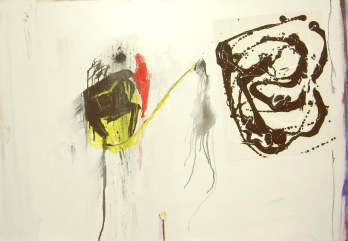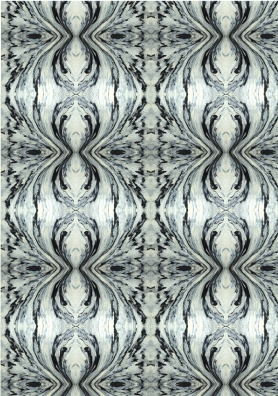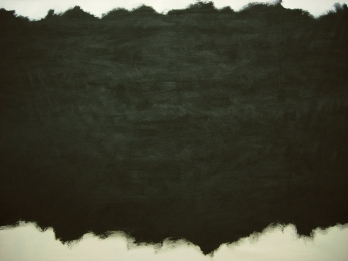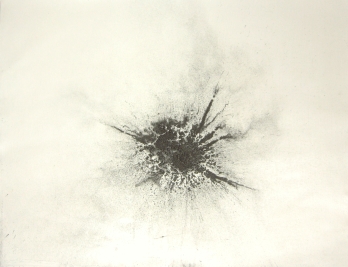Not wishing to be coy by attempting to interview myself, which seemed an impossibility to me, I asked my friend, colleague and art historian, Becky Huff Hunter, to interview me for This ‘Me’ of Mine. I have great respect for Becky’s insightful writing. She has made a career writing for art magazines like Art Papers, Sculpture and Artforum. She, in fact, is the person who encouraged me to write and so it comes back around.
BHH: What prompted you to explore questions of the self and context in your own work? Was it initially a practice-led or reading-led project, a response to personal circumstances, or something else?
JB: It was a mix of those things really. Naturally, I am attracted to certain issues because of personal experience so the things I find interesting to read and which are meaningful for me are related to the things I’ve experienced and they are the things I feel compelled to explore. When I first settled on the topic of self and context I had spent a significant amount of time studying late modernism but I was also grappling with post-modernist ideology and it just became evident to me there was a step missing between the two views of self – self which is interior and private and self which is exposed and public. I thought the middle ground between those views would be a valuable thing to explore further, looking at the relationship between context and self and the dichotomy of our own inner and outer personas and how we manoeuver amongst those influences.
Also, my personal experience has been one of having to cope with or manoeuvre through circumstances and situations, often circumstances and situations that were imposed on me by others; my childhood was a constant coping with painful impositions. As an adult, I have not always been able to pursue things as I would like because of limitations in my circumstances. I have had to find alternative ways to make things happen in order to achieve the things I wanted to achieve for myself. I’ve also had to continually measure my own understanding of who I am as an individual with how others see me or against what was expected of me. So the topic of self in relation to context is also a very personal one for me.
BHH: Could you give a little more detail on one or two of the artists or writers that exemplify these two poles of thought around the interior and exterior self?
JB: Well the first one that pops to mind is Gilles Deleuze and his book The Fold. This work is the philosophical basis for the project. In The Fold, Deleuze describes the world as filled with elements. He says individuals are a ‘concrescence’ of elements; something other than a connection or a conjunction, a ‘prehension’. He defines this ‘prehension’ as individual unity. He explains that everything carries what came before and what comes after, and so by degrees unites the world. The ‘vector’ (his word) of unification moves from the world to the perceiving subject (us) and so there is an oscillation between the public and the private; a constant unification of public and private which means we participate in our own becoming, to paraphrase Deleuze.[1]
Samuel Beckett’s Malloy, the protagonist, Jacques Moran, falls into madness through a change in context; the thin veil of socialization falls away when he leaves his normal surroundings and lives without structure, social contact, rules, social formalities. Moran is presented as an individual with specific idiosyncrasies, e.g. belligerent personality, bullying behaviour, a compulsive orderliness etc. These idiosyncrasies turn to madness with the loss of a social order and structure. He loses himself in time, he loses his sense of right and wrong, he loses personal restraint, and he feels the loss of his sense of self with the change of his context. With this change of context, Moran loses his public self, the self which knows and adheres to the rules of proper conduct and falling into madness his inner self, a self of paranoia, surfaces. There is also the possibility that Moran is Malloy, his pre and post self as one unified whole which carries the residue of two or possibly many. This is related to Deluze’s concept of ‘prehension’ above.
Frank Stella’s Die Fahne Hoch! (Flags on High!) – this painting inverts perception of what is ground and what is foreground. The unprimed canvas stripes which are actually the ground, appear to be in the foreground, as if they sit on top of a black ground. Likewise, the painted black stripes seem to be the ground when in fact they sit on top of the unprimed canvas. The title was also the official marching song of the Nazis which when considered in the context of This ‘Me’ of Mine, brings a sociological/psychological question of personal identity and group identity. Does the self define the group or the group define the self? I discovered recently there is a visual connection in one of the works in This ‘Me’ of Mine which is directly related to Nazis indoctrination and to this question, something I wasn’t aware of when I chose the work.
BHH: You’ve written that Aly Helyer’s work Strange Fruit was the starting point for conceptualizing This ‘Me’ of Mine. Did you see links between her practice and your own? How did your thoughts on the exhibition spread outwards from her piece?
JB: Initially, I was attracted aesthetically to her pieces. I was smitten by the beauty of their abstraction, the simplicity of their form, the starkness of black and white, the complexity of the tension they presented – I wished I had made them. And as Aly continued with her presentation for the exhibition Extra-ordinary, where I originally saw these works, speaking about the personal difficulties she experienced when she made these works, there just was a profound yet vulnerable attachment to the images, which I saw as Aly’s presence in the work. This is something I personally relate to, yes. My work comes from my life experience, there’s no way for me to stop that, it’s not something I control, so I think I felt a connection to Aly’s work because of that. I think her pieces became a sort of anchor-point in that I wanted to bring in other work which shared that sense of vulnerability but in more tangible realistic terms. I wanted to balance the utter abstractness of her work with work which could be easily identifiable. I think without realizing it at the time, Aly’s work represented the unspeakable emotion, that deep seeded stuff none of us want to express, of the show premise and I instinctively felt I needed to counterbalance that. David Riley’s piece Bar EP Blues is another piece which I see as an expression of raw emotion but it is the kind of visible emotion we experience; if you like, it’s the emotion we can see pass over people’s faces. So while his piece is also abstract, it is easily readable as a more visible emotion. Right there is a contrast between emotion as an inner experience and as an outer presence.
BHH: The title of your own work included in This Me of Mine is Poof! Its title and form allude to fleeting experience, a magician’s disappearing act. But the graphite clings defiantly to the gesso, as if it’s frozen in the act of disappearing. Its dark, scaly surface looks petrified or fossilized, but it also reminds me of the way a photograph indexically preserves long-gone experience. In your description of ‘Situated Self’, your online portfolio series which contains Poof!, you observe that “we each of us exist in time and perceive of our existence in the world.” Do you identify with my impression of Poof!? What, for you, is Poof’s relationship to time?
JB: Yes, I do identify with your impression, in so far as I realize it is the way most viewers see the work, and in many ways that is fine with me, I’m delighted people are amused by its humour. However, there is a deeper meaning to Poof! which deals with existence, life and death, witness and the residue left in the aftermath. The notions you mention of petrification and fossilization are applicable to things beyond natural science, this happens with emotions too. This is at the heart of the meaning of Poof! The suggested dimensionality of space, the space evacuated by something once there, as in the magician’s act, also acts as a reference to dimensionality of meaning in two vantage points; there is the thing/person disappeared and the thing/person left behind to witness the disappearance. The thing/person disappeared is gone in an instant, time and existence is extinguished. The thing/person which witnessed the disappearance is left with a residue of shock, a moment seared and scorched in memory and the rest of time is measured by this split second of disappearance; as you suggest an “indexical preservation of long-gone experience”. Time is the ultimate context. For me, the relationship to time in Poof! quite simply is the expression of the fragility of existence; it could end at any moment. It is the moment when context takes the game.
[1] Deleuze, Gilles, The Fold, Athlone Press 1993, reprinted by Continuum Publishing 2001-10, p.88, “Everything prehends it antecedents and concomitants, and by degrees, prehends the world…[t]he vector of prehension moves from the world to the subject, from the prehended datum to the prehending one…thus the data of a prehension are public elements, while the subject [the prehending one] is the intimate or private element that expresses immediacy, individuality and novelty…[e]ach new prehension…is at once public and private, potential and real, participating in the becoming of another event and the subject of its own becoming.”
We have developed a fantastic library of Suggested Reading by the artists in This ‘Me’ of Mine. Follow the links here or visit the BOOKSHOP to see all the books suggested so far. We hope you will see something inspiring for your own interests. If a book is unavailable, try the link to Abe Books.
Jane’s suggested reading:
The Death and Return of the Author by Sean Burke
Art Since 1900 by Hal Foster,Rosalind Krauss, Yve-Alain Bois, Benjamin H. D. Buchloh, & David Joselit
Perpetual Inventory by Rosalind Krauss
Painting edited by Terry Myers
The Art of Richard Diebenkorn by Jane Livingston
Cy Twombly Cycles & Seasons edited by Nicholas Serota
September: Gerhard Richter by Robert Storr
Culture in the Age of Three Worlds by Michael Denning
Tractatus Locico Philosophicus by Ludwig Wittgenstein
Difference and Repetition by Gilles Deleuze
The Complete Works of William Shakespeare by William Shakespeare





[…] more of my interview, When Context Takes The Game, conducted by Becky Huff Hunter for This ‘Me’ of […]